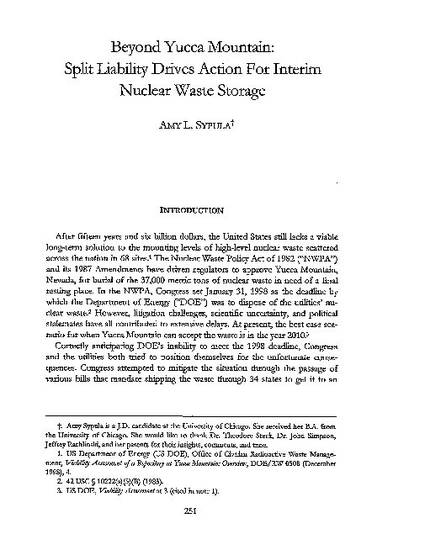
After fifteen years and six billion dollars, the United States still lacks a viable long-term solution to the mounting levels of high-level nuclear waste scattered across the nation in 68 sites. The Nuclear Waste Policy Act of 1982 (“NWPA”) and its 1987 Amendments have driven regulators to approve Yucca Mountain, Nevada, for burial of the 37,000 metric tons of nuclear waste in need of a final resting place. In the NWPA, Congress set January 31, 1998 as the deadline by which the Department of Energy (“DOE”) was to dispose of the utilities' nuclear waste. However, litigation challenges, scientific uncertainty, and political stalemates have all contributed to extensive delays. At present, the best case scenario for when Yucca Mountain can accept the waste is in the year 2010.
This Comment consists of five Parts. Part One explores the background of the nation's nuclear waste policy and Yucca Mountain. Part Two examines some of the reasons for the continual delays in constructing a permanent repository at Yucca Mountain as the precursors to the Indiana Michigan suit. Part Three sets forth an analysis of case law dealing with the DOE's liability for not meeting the January 1998 deadline. Part Four considers the impact that these legal holdings will have on the near-term nuclear waste dilemma. Specifically, the liability for disposal as distinct from taking title to the spent fuel, the corresponding financial ramifications, and incentives for near-term action will be addressed. Part Five concludes with an evaluation of potential remedies that will provide near-term solutions. By shifting the expectations of the parties and balancing the liability between DOE and the utilities, the D.C. Circuit may have provided the needed impetus to break the current stalemate. Instead of a Yucca Mountain-focused approach to nuclear policy, the parties may realize that compromise and alternative strategies are also necessary to provide assurance to the industry, the DOE, and the public that the nuclear waste will be safely contained in the short-term as well.

This article was published under the author's former name, Amy L. Sypula.